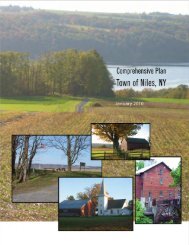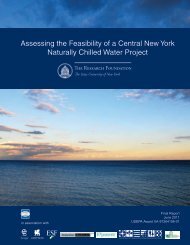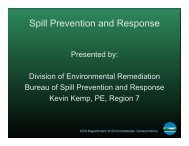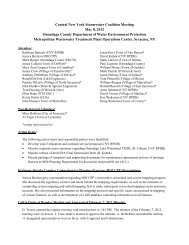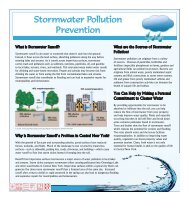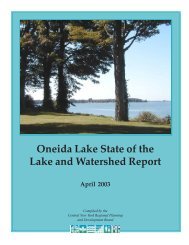A Management Strategy for Oneida Lake and its ... - CNY RPDB Home
A Management Strategy for Oneida Lake and its ... - CNY RPDB Home
A Management Strategy for Oneida Lake and its ... - CNY RPDB Home
You also want an ePaper? Increase the reach of your titles
YUMPU automatically turns print PDFs into web optimized ePapers that Google loves.
ter level conditions in <strong>Oneida</strong> <strong>Lake</strong> <strong>and</strong><br />
outlet channels during navigation <strong>and</strong> the<br />
non-navigation seasons. The greatest<br />
amount of water level variation (which<br />
exceeds our “control”) occurs during the<br />
non-navigation season -- especially during<br />
the spring freshet or January thaw periods.<br />
This water (precipitation) is placed into<br />
natural storage (snow <strong>and</strong> ice) that then melts.<br />
Little water can be stored in the soils or<br />
uptaken by vegetation, which lies dormant<br />
during the winter <strong>and</strong> early spring, there<strong>for</strong>e<br />
most of the ‘stored’ water is available as<br />
runoff. Sometimes the melting of this stored<br />
water is increased by heavy rains that further<br />
add to the sum total of water available as<br />
runoff within the watershed. At this point,<br />
runoff begins <strong>its</strong> rapid decent from the surrounding<br />
hills down to the lake <strong>and</strong> adjacent<br />
wetl<strong>and</strong>s, but this water does not readily leave<br />
the lake as the gradient downstream of the<br />
lake outlet is many times less than that of the<br />
surrounding upl<strong>and</strong> areas.<br />
There<strong>for</strong>e we have two aspects to be aware of<br />
when trying to underst<strong>and</strong> what is happening<br />
in our watershed:<br />
Watershed conditions: The response of the<br />
lake to <strong>its</strong>’ watershed -- the amount of water<br />
available to run off within the upl<strong>and</strong> watershed,<br />
how quickly the water can get to the<br />
downstream end of the watershed, how much<br />
water can be held within the lake, <strong>and</strong> what<br />
lake elevation is it acceptable (high <strong>and</strong> low<br />
levels) be<strong>for</strong>e ‘adverse’ damages occur<br />
Water-control (structural) conditions: What<br />
are the physical features of the structure that<br />
holds the water in the lake, how quickly could<br />
it be released from that structure, <strong>and</strong> what<br />
controls the volume of water that can be<br />
carried (discharged) downstream of the<br />
structure<br />
A surprising revelation during the May 2003<br />
water-level management meeting was that the<br />
group (all parties) appeared to feel that during<br />
the navigation season, natural high water<br />
events do occur, that we can’t control these,<br />
<strong>and</strong> we have to live with them. But, the spring<br />
freshet period (usually a longer duration<br />
“event”) appears to be a different case, one in<br />
which we could do a better job of controlling,<br />
either through getting the water out of the lake<br />
faster, or lowering the lake in anticipation of<br />
the “event” to reduce/mitigate <strong>its</strong> effects.<br />
Un<strong>for</strong>tunately you can’t have it both ways -- it<br />
is the same watershed, it is the same rapid<br />
movement of water from the headwaters to the<br />
lake, but the difference is that the ‘runoff<br />
event’ usually occurs basin-wide. The lack of<br />
a means to get this water out any one particular<br />
sub-basin is compounded across the entire<br />
Oswego River Basin <strong>and</strong> the entire system<br />
‘bogs-down’ due to the overall volume of<br />
water that is running off. Navigation season<br />
events are usually not basin wide, there<strong>for</strong>e<br />
the Oswego system can h<strong>and</strong>le sub-basin<br />
storms more readily. The exception is the<br />
Hurricane Agnes type of event that was<br />
basin-wide.<br />
Appendices page 97



